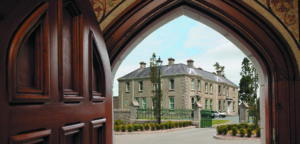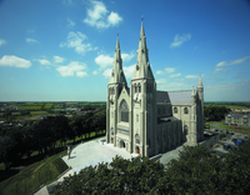RE-OPENING OF ST. JOHN THE BAPTIST CHURCH, DRUMCREE, PORTADOWN
SUNDAY 28 NOVEMBER 2004
HOMILY GIVEN BY MOST REV SEÁN BRADY
I congratulate all concerned in this beautiful re-ordering of your Church – the Church of St. John the Baptist, Drumcree, which we rededicate to the glory of God today. Built in 1977 this Church replaced ‘Old St. John’s’ which was sited, as you know, in the cemetery nearby and which had served the parish as a house of prayer and place of worship for almost two hundred (200) years. As many of you also know – old St John’s is now relocated in Cultra Folk Museum as an example of an 18th century barn-church.
Built around 1777 old St. John’s was the mother Church of the parish. St. Patrick’s, William Street came later, in 1835, when the growth in the 19th century created the necessity for a church in that part of town.
When this Church opened in 1977 it was a project planned and executed in less than two years by the late Dean MacLarnon – then Parish Priest of Drumcree. Hundreds of families had migrated rather suddenly to the Garvaghy Road as a result of troubles, which were widespread in other parts of the town throughout the 1970s. There was an urgent need for a new church, I am told, and that it was provided hastily on a rather limited budget. It was to the credit of Dean MacLarnon and of the faithful generous people of this parish that within a year of its opening, all the debt was paid. There was, however, an understanding that as soon as possible, the interior would be made more ornate and beautiful. Happily this has now been done. I rejoice with all of you who, under the leadership of Father Larkin, have seen this project to its conclusion.
The opening of St. John’s in October 1977 was the first liturgical function presided over by Archbishop, later Cardinal Ó Fiaich just two weeks after his episcopal ordination as Archbishop of Armagh. The Church has, thus far, served over a generation of the faithful along with its sister Church, St. Patrick’s which Canon Early entirely re-ordered and refurbished in the 1980s.
Canon Early’s funeral was one of the last to take place in St. John’s before it closed last year for the present refurbishment. He is buried just inside the cemetery gates. That is entirely appropriate since it was he who extended and renovated St. John’s cemetery over ten (10) years ago including a paved seating area on the site of the original St. John’s Church. Dean MacLarnon died recently when the present renovations were well advanced.
The parish of Drumcree has now two beautifully appointed churches thanks to the faith and generosity of the people and the labours of its pastors, past and present. For all of this we are gathered here today to give thanks and praise.
This Church was dedicated to John the Baptist – a man who comes into his own at this time every year. His message was strong and clear – ‘Repent for the kingdom of God is near’. The whole point of his preaching was that his audience might see the foolishness of their ways and change and have their sins forgiven. It was a tough message because change is always tough and the older you get the tougher change becomes. Yet people flocked to hear John because people saw that what John said made sense. Even though his words challenged them those words gave them hope.
So, once again the words of John the Baptist will ring out in this Church as they have done in this place every December for the past 227 years. Many will hear those words. Others, unfortunately, will not hear them or heed them. But for those who listen and heed the call to forgiveness, it will make the difference of a really happy Christmas. Jesus has left us a great way to find peace and happiness – a way to get rid of our guilt and shame. It is the sacrament of Confession, which brings pardon and peace to those who ask it.
Today the Roman Catholic, Anglican and Lutheran traditions all recall the imagery of the swords being hammered into ploughshares and spears into pruning hooks. The message is a strong one. I believe it is particularly timely for all of us here in Northern Ireland for it is both hopeful and challenging.
Swords and spears are symbols of war. They are instruments of offensive attack. They mean death and destruction, maiming and laming, wounding and disabling. We have had far too much of that already. Hopefully it will all soon be a thing of the distant past.
Ploughshares and pruning forks on the other hand suggest a totally different scene. The ploughman turns over, not a new leaf, but a new sod. He tills the ground. The soil is made ready to receive the seed. Fresh growth springs forth bringing hope and joy. Pruning hooks lop off dead and overgrown branches. They make way for new shoots to blossom and bear fruit.
For years, the people of Northern Ireland have waited patiently for the kind of peace envisaged by the prophet Isaiah almost three thousand years ago. They know well that there is a season for everything, a time for every occupation under Heaven – time for keeping and a time for throwing away. Many believe that that season is now here. Hopes are high for a new dawn – for an era of new relationships. I believe that these new relationships are possible and that they should be characterised by generosity and understanding, mutual respect and courage, as well as forgiveness and patience.
In recent years the people of Northern Ireland have made a remarkable journey. Some are weary of that journey and believe that nothing more can be done. Others continue to hope that generosity and new approaches to old problems can bring a brighter future. My appeal to everyone in our society is to continue to work in favour of hope. To believe that new relationships and better times are always possible.
In seeking to resolve our problems there is always the temptation to make the perfect solution the enemy of the good solution. Yet a good solution can create the opportunity for better solutions to emerge in time. So I appeal to all involved in the negotiations to grasp the good opportunity that now presents itself and to give us reasons to hope for new possibilities and for a new beginning to our shared future by reaching agreement in the coming days. For, should these hopes be once more dashed, then the only winners will be the cynics, and the losers, the people who believed that locally elected representatives could take responsibility for our local situation.
The prospect of a situation where people’s and nations will no more lift up sword against nation, and where there will be no more training for war, is almost overwhelming. But the reports are that this is exactly what our politicians are hammering out these days.
The rest of us must not just stand around and do nothing – the minimum is that we accompany the politicians and their officials with our prayers and best wishes. Peace is at once a value and a duty. We need to hammer out and transform, in our own lives, those attitudes of bitterness which are hostile to peace, and which threaten the dignity and respect due to everyone as a human person. We need to lop off the old hatred and suspicion and intolerance so that peace can begin to take root as a value deeply embedded within the heart of every person. In this way it can spread to families and to the different groups and associations within our society until the whole of the community is involved.
Followers of Christ are interested primarily in the peace of Christ. The peace of Christ is, in the first place, reconciliation with the Father. But peace is also reconciliation with one’s brothers and sisters. In the prayer that Jesus taught us, the “Our Father”, the forgiveness that we ask of God is linked to the forgiveness that we give to our brothers and sisters. That is the authentic foundation of any real and lasting peace.
Yes, the vision of universal peace given to us by Isaiah, can seem like something of a dream, but I am convinced that this dream can come true. In a society where the welfare of every human person is safeguarded and people try to share freely and trustingly with one another the riches of their minds and their talents, what once seemed impossible becomes possible and the civilisation of love itself, can become a reality.
Your Church is being re-opened at the beginning of the Year of the Eucharist – Announcing the year, Pope John Paul II asked for two things:
A renewed attention to the celebration of the Sunday Mass and secondly,
A great appreciation of the real presence of Jesus in the Blessed Sacrament leading to more time being spent in adoration of the Blessed Sacrament.
I am very grateful and appreciative of the work that has been done in preparation for the celebration of this Mass. I hope and pray that the spirit of generosity and co-operation and willingness will continue to be a mark of every Sunday Eucharist in this parish.
I also hope that, especially during this season of Advent, adoration of Jesus will be a permanent feature of the life of this Church. Jesus came in the flesh from the womb of Mary nearly 2000 years ago. He will come again in glory at the end of time. But for now, the meantime, we have his promise – ‘Behold, I am with you always to the end of time’. We have the outstanding example of the fulfilment of that promise in the Blessed Sacrament of the Eucharist. It is that strong fidelity which has inspired the faithful people of Drumcree to build and maintain beautiful churches and altars and sanctuaries. Happy are those who ar called to the supper of the hands of God – who takes away the sins of the world. They always want the best possible setting for that supper and they shall have their reward.



You must be logged in to post a comment.